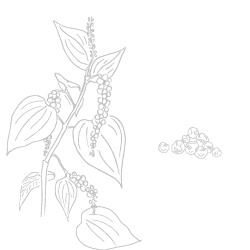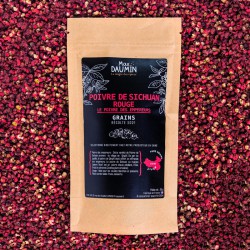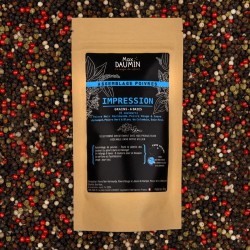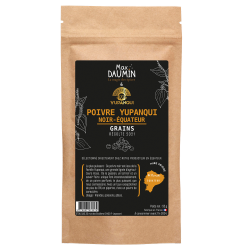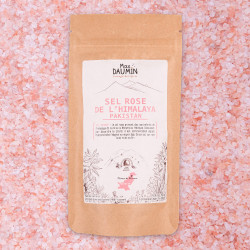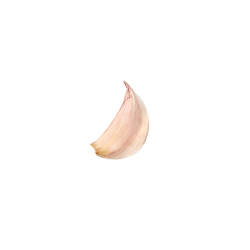-
- Our Berlingots Blends Bouquet Garni from France Fish and Seafood Bouquet Garni Cajun blend Plant-based cuisine Curry Homemade Recipe Curry Intense Homemade Recipe Thaï Red Curry Thaï Green Curry Spices Grill & Plancha Organic Provencal Herbs from Provence Four Spices Faraony Valley Ras El Hanout Traditional Recipe Zaatar Guacamole Spices Mix Gingerbread Spices Mix Coffret Assemblage Foie Gras Mulled Wine Spice Mix
- Pure Spices Berlingots Garlic from France Bear's garlic from Ain Ceylon cinnamon Organic Clove from Madagascar Organic coriander from France Cumin from India Organic turmeric from Madagascar Organic Tonka bean harvested in Guyana Organic ginger from Madagascar Nutmeg from Sri Lanka Sweet Paprika from Hungary Smoked Paprika from Hungary Ancho Rojo pepper from Mexico Bourbon Vanilla Powder – Gourmet
- Berlingot peppers Organic black pepper from Madagascar Voatsiperifery Wild Pepper Treetop pepper
- Espelette pepper Espelette pepper Ezpeletako Biperra
- Berlingot vanilla Bourbon Vanilla Powder – Gourmet
- Bulk ground spices Bouquet Garni from France - Bulk Organic turmeric from Guadeloupe bulk copy of Organic turmeric from Guadeloupe bulk Homemade Recipe Curry - Bulk Grill & Plancha Spices - Bulk Ras El Hanout Traditional Recipe - Bulk Sumac from Sicily bulk
- Vrac berlingots à composer Sachet vrac berlingots
-
- Vanilla pods Bourbon vanilla from Madagascar – Gourmet & Bio Vanilla Tahitensis Haapape Bourbon Vanilla Powder – Gourmet
- Saffron Saffron pistils from Afghanistan - Neguine
- Bulk Spices Star Anise - Badian copy of SilTimur berry or Tchuli pepper Organic Pink Berry from Madagascar Ceylon Cinnamon - Pipes Cardamom Whole Organic Clove Organic coriander from France Organic Fenugreek from France Whole Organic Tonka Bean from Guyana Whole nutmeg Jamaican pepper Pili-Pili Bird Pepper
-
- Peppercorns Yupanqui green pepper Yupanqui black pepper Yupanqui white pepper Smoked Yupanqui black pepper Black pepper from Kampot Organic & PGI Organic & PGI Yellow Kampot Pepper Organic & PGI Red Kampot Pepper Phu Quoc black pepper copy of Phu Quoc black pepper Karimunda pepper – Kerala (India) Black pepper from Madagascar Organic Tasmanian Pepper Berry Voatsiperifery wild pepper from Madagascar Likouala wild pepper Organic Timur wild pepper SilTimur berry or Tchuli pepper Red Sichuan Pepper Wild treetop pepper Blend of Peppers - Sensation Blend of Peppers - Explosion - Organic Blend of Peppers - Impression
- Crystal salts Pink Himalayan Salt - Crystals Persian Blue Salt - Crystals Hiwa Kai black salt from Hawaii Kala Namak salt or Himalayan black salt - Crystals Black Forest Smoked Salt Utah Sweet Salt - Crystals Guérande Flower of Salt
- Salts and Spices Blend Salts - Sauvage Organic Salt Blend - Lemon Blend of Organic Salts - Fou Blend Salts - Spicy Organic Cinq Baies Salt Blend - Scented
- de Buyer pepper mills De Buyer Rumba Pepper Mill - Steel Mechanism De Buyer Natural Wood Jota Pepper Mill De Buyer Boogie Pepper Mill Natural Wood - Steel Mechanism Mixed Salt/Pepper Moulin de Buyer De Buyer Paso Pepper Mill Natural Wood De Buyer Paso Pepper Mill Dark Wood De Buyer Boogie mixt Salt Pepper Mill
- de Buyer salt mills De Buyer Rumba Salt Mill - Steel Mechanism De Buyer Salt Mill JOTA Ebony De Buyer Salt Mill Boogie Natural Wood - Steel Mechanism Mixed Salt/Pepper Moulin de Buyer
- de Buyer nutmeg mill De Buyer SOKO Nutmeg Mill
- Box de Buyer mill & Kampot pepper De Buyer Pepper Mill Box + Organic Kampot Black Pepper & PGI
-
- Spiced Tea box The Fabulous spiced teas
- Thé Chaï Classic Chai tea Chaï Ayurvédique Chaï Masala Détox Chaï Cardamome Bombay Cutting Chai
- Berlingot Spiced Tea Berlingot Classic Chai tea Berlingot Ayurvedic Chaï tea Berlingot Cardamom Chaï tea Berlingot Masala Detox Chaï tea Berlingot Bombay Cutting Chaï tea
-
- Spiced cocoa boxes The sublime cocoas with spices The sublime cocoas with spices & exotic fruits Box of 6 cocoas with spices
- Berlingot Cocoa Berlingot Cocoa Tonka Vanilla Berlingot Cocoa Raspberry Rose Cardamom Berlingot Cocoa Combava Timur Cocoa Berlingot Sweet Orange Ceylon Cinnamon Berlingot Cocoa Grand Cru Plain Berlingot Cocoa Ginger of Madagascar Berlingot Cocoa Litchi Ceylan Cinnamom Berlingot Cocoa Passion Fruit Lemongrass Berlingot Cocoa Dragon Fruit Strawberry Sichuan green Berlingot Cocoa Cherry Tonka beans Berlingot Cocoa Espelette Pepper
- Chocolat aux épices Coffret Chocolat aux épices - Route des Indes
-
- Boxes to compose 20 Spices box 3 Flavors box Box of 6 cocoas with spices Box 3 boxes Sachet vrac berlingots
- Gift boxes Enhance your everyday ! Surprise your guests! Delight your loved ones! The Fabulous spiced teas The sublime cocoas with spices The sublime cocoas with spices & exotic fruits Coffret Chocolat aux épices - Route des Indes De Buyer Pepper Mill Box + Organic Kampot Black Pepper & PGI
- Integrals Integral 14 Integral 18 Integral 20
- Assortment Box Guacamole Spices Mix Gingerbread Spices Mix Coffret Assemblage Foie Gras Mulled Wine Spice Mix
- Miels Miel & Vanille Bourbon copy of Miel & Vanille Bourbon copy of Miel & Vanille Bourbon copy of Miel & Vanille Bourbon
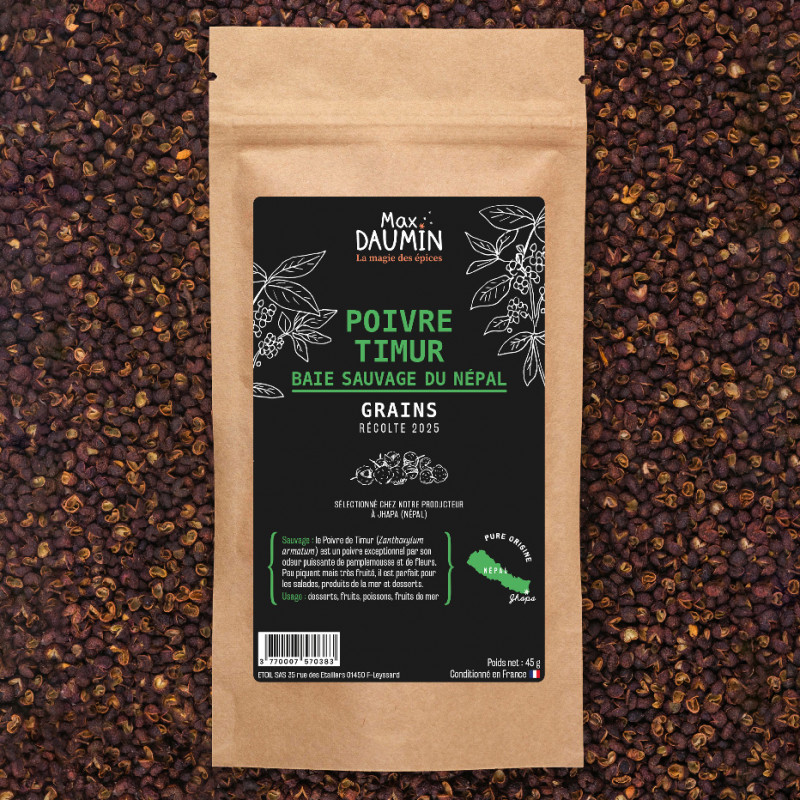







Organic Timur wild pepper
Often called Timut, it is called Timur in Nepal where we find its origin. This organic pepper harvested wild in the mountains of Nepal develops powerful flavors of grapefruit and exotic flowers.
Its incredible flavor will add remarkable touches to seafood, salads, Asian dishes, chicken, but also desserts and chocolate!
-
Net weight : 45g
-
Usage : Fish, Seafood, Desserts, Pastries, Fruits

History
Plant & perfume
This fine and delicious pepper has a spiciness similar to that of Sichuan pepper but much less powerful. Its very particular sensory characteristic with a taste of grapefruit and candied lemon which comes just after the small, slightly spicy notes.
Also called Timut pepper, Timur pepper (Zanthoxylum armatum) is a shrub tree 5 to 6m high that will give berries that strangely resemble tiny kaffir lime. The berry once dried opens in a small lobe revealing the seed. Only the seed coat is kept.
These grapefruit and lemon fragrances are due to a very simple reason: the genus Zanthoxylum belongs to the large family Rutaceae. And the Rutaceaes are simply the citrus family!



Benefits
Cooking and Virtue
Timur pepper works great when used to season green vegetables as well as in any dish that requires an exotic, citrusy edge.
In more detail the bay of timut is made for fish, crustaceans, shellfish. Its plampemous citrus notes will perfectly enhance your seafood-based recipes. This pepper easily enhances a fruit salad and will find its place on white meat. It enhances sauces, soups and stews very well. Find recipes with timut pepper in our grimoire.
It also works very well in the sweet chapter: with compotes, jams, cakes, biscuits, chocolates, panna cotta, creams, fruit salads, etc…

Origins
A long journey
With the development of peppers over the past twenty years, the appearance of Sichuan pepper (used in China) in Europe has encouraged interest in berries belonging to the genus Zanthoxylum such as Sancho berry or Timut Bay.
Nevertheless it was classified and "discovered" in 1824 by the botanist Augustin Pyramus de Candolle.In Nepal, its origin, it has been used for centuries in the kitchen, especially in their chutneys .


16 other products in the same category:
Red Sichuan Pepper
Likouala wild pepper
Blend of Peppers - Sensation
Yupanqui green pepper
Black pepper from Madagascar Organic
Blend of Peppers - Impression
Blend of Peppers - Explosion - Organic
Phu Quoc black pepper
Organic & PGI Yellow Kampot Pepper
SilTimur berry or Tchuli pepper
Yupanqui white pepper
Voatsiperifery wild pepper from Madagascar
Karimunda pepper – Kerala (India)
Wild treetop pepper
Yupanqui black pepper

Customers who bought this product also bought:
Utah Sweet Salt - Crystals
Pink Himalayan Salt - Crystals
Blend of Organic Salts - Fou
Cayenne pepper
Cocoa Berlingot Sweet Orange Ceylon Cinnamon
Garlic from France
Organic Cinq Baies Salt Blend - Scented
Likouala wild pepper






check_circle
check_circle




